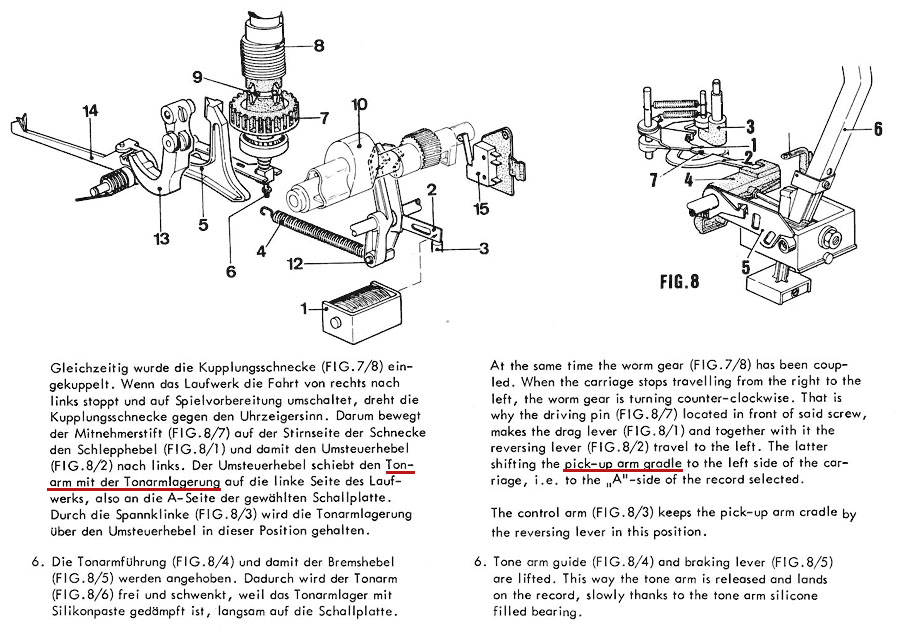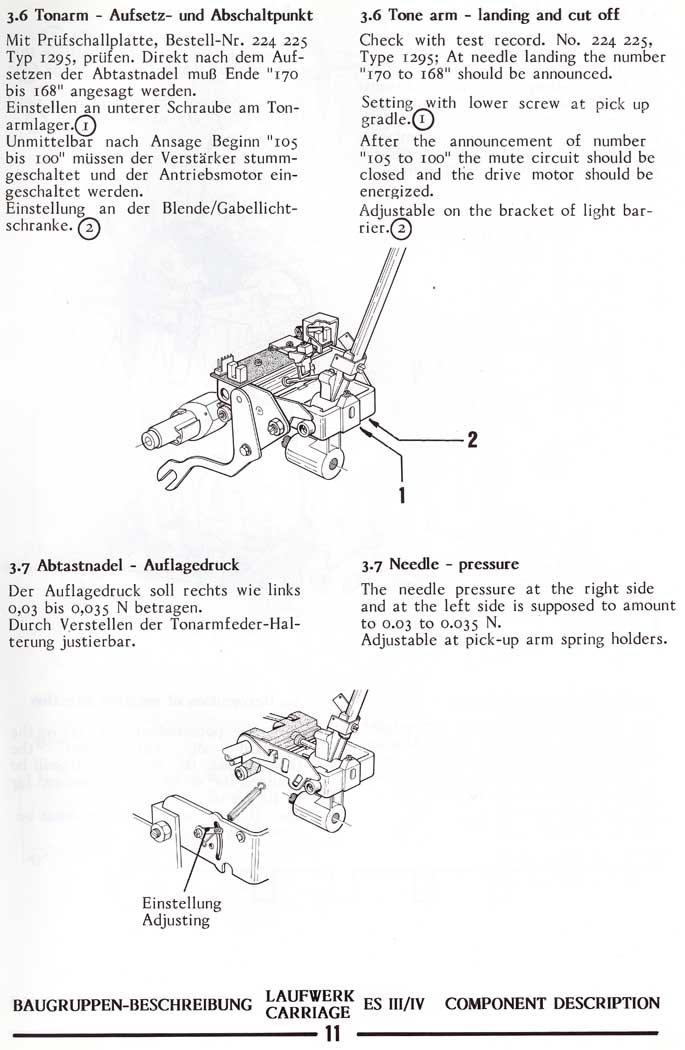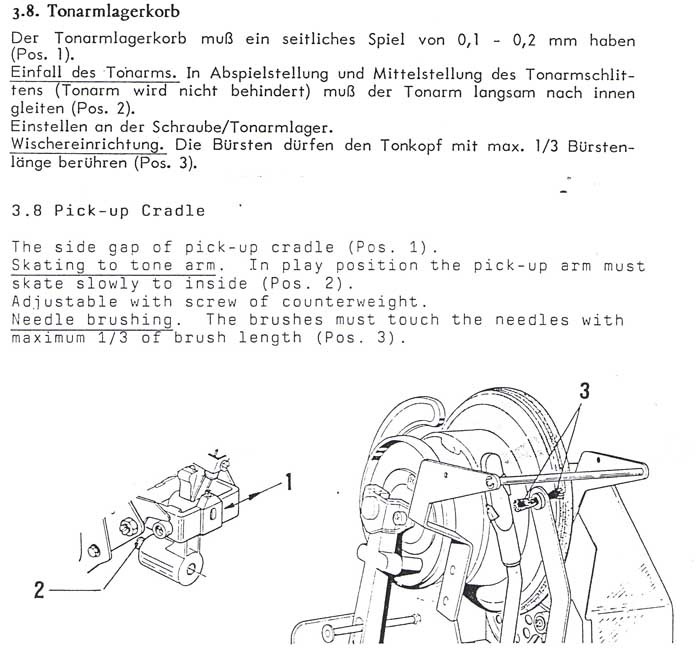Die Federspannung muss so eingestellt werden, dass der Tonarm
im Bereich der Nadel mit etwa 5 - 8 Gramm (keramisches Tonsystem) bzw. 3 - 5
Gramm
(Magnettonsystem) auf die Schallplatte drückt. Jede Feder ist durch eine
kreisbogenförmige Öffnung im Rahmen und durch eine Messingöse geführt.
Durch Verstellen der Messingöse wird der Auflagedruck eingestellt. Wenn der
Einstellbereich nicht ausreicht, kann man zusätzlich noch die Messingöse etwas
vom Rahmen wegbiegen, bis der richtige Druck erreicht ist.
Zum Einstellen wäre eine Tonarmwaage optimal, mit etwas Gefühl geht es aber auch
ohne.
Man erhöht den Druck schrittweise, bis die Platte richtig abgespielt wird.
The spring tension must be adjusted so that the tone arm
presses with the stylus with about 5 - 8 grams (ceramic cartridge) or 3 - 5
grams (magnetic cartridge) against the record. Each spring is guided through an
arc-shaped opening in the frame and through a brass eyelet.
The pressure is adjusted by moving the brass eyelet. If the adjustment range is
not sufficient, the brass eyelet can be bend slightly away from the frame until
the correct pressure is reached.
A tonearm scale would be ideal for adjusting the pressure, but with a little
sure touch it can be done without.
The pressure gets increased gradually until the record is played correctly.
Dies
geschieht mittels einer Schraube mit der darunter liegenden Haltefeder an der
rechten unteren Seite des Tonarmlagers. Hierbei ist unbedingt darauf zu achten,
dass nur die unterste der beiden Schrauben verstellt wird (etwas nach links
versetzt). Die darüber liegende dient zur Justage des Endabschaltpunktes und ist
mit Sicherungslack versehen.
Die Einstellung ist richtig, wenn die Nadel
ca. 2-3mm vom Rand entfernt aufsetzt.
This gets done using a screw with the
retaining spring below on the lower right side of the tone arm bearing. It is
strictly needed to ensure that only the lowest of the two screws gets adjusted (slightly
offset to the left). The upper one is used for the adjustment of the cut-off
point and is provided with locking lacquer.
The adjustment is correct when the needle touches down approx. 2-3mm from the
edge.
Unter der
rechten Tonarmfeder beim Laufwerk ist ein grau-beiger Kunststoffbügel, in dem
ein Magnet eingegossen ist. Dieser Bügel bringt den Reed Kontakt zum Abschalten.
Der Reed Kontakt ist in grauem Kunststoff verkleidet und sitzt hinter dem viereckigen
Tonarm. Den beschriebenen Kunststoffbügel kann man mit einer Schraube an der
rechten Seite des Tonarmes justieren, er gehört minimal etwas weiter an den
Reedkontakt herangeführt.
Bei späteren elektronischen Modellen kann statt
des Reed-Kontaktes eine Lichtschranke eingebaut sein.
Below the right tonearm spring at the
carriage is a gray-ecru coloured plastic bracket that has a magnet molded into
it. This bracket brings the reed contact to switch off. The reed contact it is
covered in gray plastic and sits behind the square tonearm. The described
plastic bracket can be adjusted with a screw on the right side of the tonearm,
it needs to get moved a little bit closer to the reed contact.
Later electronic models may have a light barrier installed instead of the reed
contact.
Meine NSM Hit 120 läuft ca. 1 Std. einwandfrei. Dann werden die Singles nicht mehr zurückgelegt, so dass der Cancel-Knopf betätigt werden muss. Danach funktioniert wieder alles einwandfrei.
My NSM Hit 120 plays troublefree for ca. 1 hour. Then the records do not get returned and the cancel knob needs to be pressed. After doing so all works fine again.
Wenn der
Cancel-Knopf funktioniert, dürften Mechanik und Kupplungsmagnet in Ordnung sein.
Der Fehler ist also im Bereich des Endschalters zu suchen.
Der Endschalter
ist ein sogenannten Reedkontakt, der durch Einwirkung eines Magnetfeldes
betätigt wird. Der Reedkontakt ist in einem Kunststoffgehäuse, das auf einem
schwenkbaren (zum Einstellen des Abschaltpunktes) Hebel sitzt.
Auf dem Tonarm ist der Magnet montiert, der den Reedkontakt betätigt.
Möglicherweise ist in diesem Bereich etwas locker, so dass sich der Abschaltpunkt
bei Erwärmung verändert. In dem Fall müsste die Platte weggeräumt
werden, wenn der Tonarm am Ende der Platte angehoben wird (um die Nadel
nicht zu beschädigen) und weiter in Richtung Plattenmitte bewegt.
Als weitere
Fehlermöglichkeit wäre vorstellbar, dass das Schleppkabel gebrochen ist und bei
Erwärmung unterbricht. Beim Abkühlen zieht sich die Kunststoffisolation zusammen
und der Kontakt wird wieder hergestellt.
If the cancel button works, the
mechanics and the clutch solenoid should be OK. The fault is therefore to be
found in the area of the cut-off switch.
The cut-off switch is a so-called reed contact that is actuated by the action of
a magnetic field. The reed contact is housed in a plastic case that sits on a
pivoting point (for setting the cut-off point). There is a magnet mounted on the
tone arm that actuates the reed contact.
There may be something loose in this area, causing the cut-off point to change
when it heats up. If this is the case, the record would have to be returned when
the tonearm gets lifted off the record at its end (so as not to damage the
needle) and move it further inwards to the center of the record.
Another conceivable possibility is that the trailing cable is broken and
interrupts when heated. When cooling down, the plastic insulation contracts and
the contact gets re-established.

Die Angaben haben keinen Anspruch auf Vollständigkeit oder Richtigkeit.
Bei den (importierten) Boxen können im Laufe der Jahre durchaus Veränderungen
vorgenommen worden sein. Copyright.

Copyright by Stamann Musikboxen

